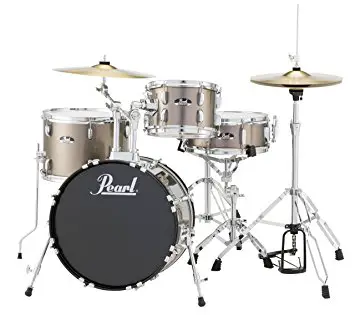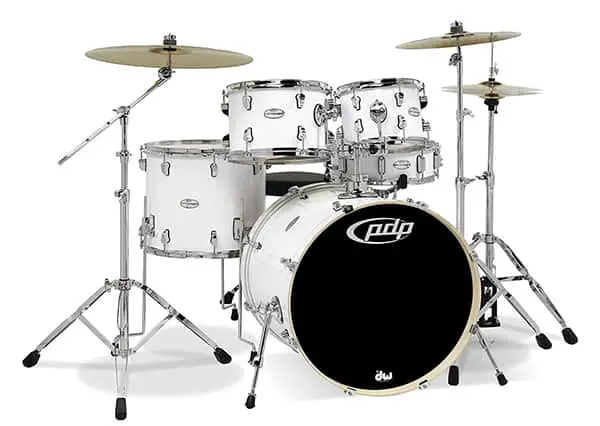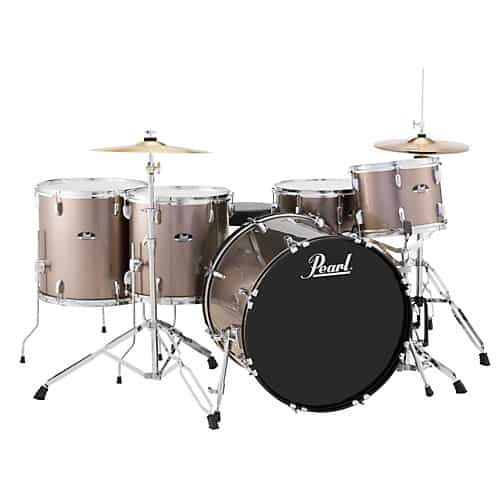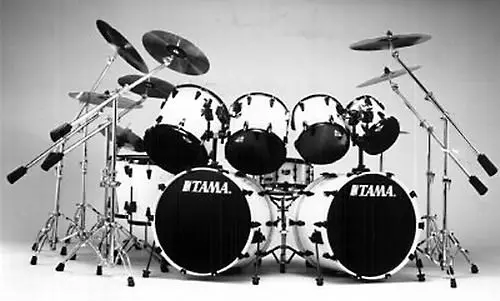
In my years of teaching beginner drum students and advising their parents, I have often been asked to provide my input what the difference is between four and five piece drum sets.
So, what’s the difference between 5 piece vs. 4 piece drum sets? Five piece drum sets typically contain one bass drum, one snare drum, one floor tom and two hang toms whereas four piece drum sets have one less hang tom. This is true for the vast majority of drum kits available on the market, where the number in the name correlates directly to the number of instruments in the setup.
As with anything, there are always exceptions and different ways to configure and setup a drum set, and so in this article I’d like to define the ‘norms’ in drum set layouts, but also discuss some of the unique ways 4 and 5 piece kits can be configured.
Common Four Piece Setup
The concept of the four piece drum set has been around for decades, dating back to before rock n’ roll became popular in the 50’s/60’s, primarily with jazz drummers. When you think of the history of the drum set itself, the majority of these early kits were 4 piece layouts – up to and including that amazing footage of the Beatles on Ed Sullivan in the early 60’s.

This setup most commonly features a bass drum, snare drum and two toms – one floor tom and one rack or hang tom. The positioning of the hang tom can vary from setup to setup, but it is most commonly mounted in the following three ways:
- A bracket our mount coming up from the bass drum
- A dedicated tom stand or rack mounting
- A snare drum stand placed to the side of the bass drum
Floor toms on the other hand are almost always free-standing on three legs, though occasionally you’ll find them suspended from a rack or stand as well.
Drummers that are most famously associated with this configuration include Ringo Starr and Dave Grohl, not to mention the vast majority of jazz drummers, both past and present.
Common Five Piece Setup
This is probably the most well known configuration of drum set as pretty much all ‘beginner drum sets’ sold on the market are made of up of one bass drum, one snare drum, one floor tom and two rack toms.
To take this notion of ‘standard’ a step further, the vast majority of these kits come with toms in the following sizes: 12″, 13″ 16″ toms with 14″ bass drums. It’s not completely clear why this has become the standard, but it most certainly is a long standing trend with minor variations throughout the years.

Earlier I mentioned the Beatles’ first appearance on TV in the 60’s – and Ringo’s famous 4 piece kit. Well – if you take a look at some of the later Beatles footage, you can see that Ringo eventually using a 5 piece kit as the parts started to get much more complex and required that extra tom.
I won’t go into specifics on artists who are known for playing 5 piece kits because practically everyone throughout the 80s and 90s had this sort of setup. Suffice it to say – the list is tremendously long.
Alternate Four and Five Piece Kit Arrangements
While there aren’t many variations of the four piece drum set (as there really is very little you can do in terms of changing that setup, there are a few ways in which the five piece kit has been ‘tampered with’ over the years.

Probably the most common version of a unique 5 piece configuration is where one of the rack toms are actually moved down to the floor so that you in essence end up with a 4 piece kit with an extra floor tom on it. This is especially popular with rock drummers.
Once classic example of this is John Bonham, as it looks like he played a four piece kit – when in reality he had an extra (monster) floor tom hanging out to his right.
Another version of the five piece kit, though not nearly as popular as the one mentioned above is one where an additional floor tom is placed to the left of the hi-hat (in a right-handed setup). This is an example of a setup which lends itself to “open handed drumming” – a technique of playing where the arms rarely cross the body. Placing an additional tom to the left allows you to play certain fills which would otherwise necessitate a crossing of the arms.
Which One Is Better: Four Piece or Five Piece?
The short answer here is that it really doesn’t matter. I mean that sincerely. If you are getting started as a drummer, the tendency is to focus really heavily on gear and getting more and more drums. Speaking from personal experience, this isn’t always the best mentality.
At first, a new drummer’s focus needs to be on A) learning the basics and B) having fun! To learn the basics, large kits are not needed. Nor are they necessary to have fun! My recommendation therefore is to do your research and pick a drumset that you feel comfortable behind…and ignore how large or small it is. Also, keeping things simple can really help you avoid frustrations (and added cost) as you get further into the drumming hobby.
You’re sitting behind a drum kit! That should be awesome as is!
If you’d like a little help from me as to what I would recommend, I did create a page in the Recommended Gear section of this site, providing you with my view on some of the best ‘bang for the buck’ kits out there for beginners.
section of this site, providing you with my view on some of the best ‘bang for the buck’ kits out there for beginners.
Other Common Drum Set Configurations
Two Piece:
This is pretty much the simplest setup out there, as it consists of only a bass drum and snare drum, not to mention whatever cymbals are needed (typically a hi-hat at least). Used commonly for street musicians, but also styles of music which don’t require a large setup, such as polka for example.
Six Piece:
There are various flavors of this and definitely not a standard, but generally it involves adding a drum to the standard five piece layout. Most commonly, this extra drum can be a bass drum (double bass), another rack tom or an additional floor tom. Once in a while, this could also be an additional snare drum.
Seven Piece:
The most common version of a seven piece drum set consists of one bass drum, one snare drum, three rack toms and two floor toms – though this can vary greatly depending on what’s required.
Nine Piece:
Probably the most famous 9 piece drum set in existence is Lars Ulrich’s monster setup from the 90’s, which consisted of two bass drums, one snare drum, four rack toms and two floor toms.

Related Questions
What are the advantages of playing a 4 piece drum set?
Having one less drum to contend with in your setup does reduce your musical options slightly, however the great benefit of a four-piece kit is that it can be easier to setup and consequently play ergonomically.
What are the pieces of a drum set called?
The large drum lying on the floor and played with a pedal is called the bass drum. The snare drum is the one setup on a stand, most commonly directly in front of the drummer and between the legs. Floor toms are drums that are setup on the floor using three legs. Hang or Rack toms are smaller drums, typically suspended from a stand or mount.
